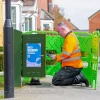CLA Expects UK Government to Miss its 2015 Superfast Broadband Target
The Country Land and Business Association (CLA), a land owners lobby group for England and Wales, has warned that the UK governments plan to help roll-out superfast broadband (24-30Mbps+) services to 90% of the country by 2015 (the last 10% will get at least 2Mbps) could be missed because of a “slow funding process” and “reliance on fibre optic networks“.
CLA President, Harry Cotterell, is expected to tell a Department for Culture, Media and Sport (DCMS) select committee evidence session on the Broadband Delivery UK (BDUK) project today that the current “process is too bureaucratic” and risks prolonging the rural-urban digital divide.
Advertisement
Harry Cotterell, CLA President, warned:
“We recognise that delivering this type of infrastructure is not easy but it is unlikely the Government will meet these objectives.
The BDUK process is too bureaucratic and the allocation of the £530 million funding too slow. It would be much simpler if the funding was allocated centrally rather than giving it directly to local authorities because they do not have the resource to plan for a superfast broadband network.
An over-reliance on fibre optic is also a factor in the Government’s poor chance of meeting these deadlines. The CLA advocates a patchwork quilt model that uses the most appropriate technologies for a certain area, rather than using a single technology, so everyone can benefit from broadband.”
In fairness we’re not convinced that the central government has any more resources than local authorities to tackle the problem and at least councils should, in an ideal world where everything actually works and we’re all rich, have a better understanding of the unique local challenges. Unfortunately no politically managed process seems able to run without some level of bureaucracy.
As to the issue of whether or not a single non-fibre based technology would be best? Sadly that’s difficult to examine without knowing precisely what the CLA actually has in mind. Past articles lead us to suspect that the CLA might be referring to the next generation of “4G” superfast Mobile Broadband services or something similar, yet even wireless can’t reach everywhere and has its own unique challenges.
Indeed it’s sometimes easy to forget that most viable superfast wireless solutions can’t actually deliver such a service without first being supplied by capacity from a strong fixed line connection (usually a fibre optic line with some small uptake of Microwave alternatives), thus a patch-work approach with different solutions is difficult to avoid.
Mr Cotterell also noted that the CLA and NFU were still “engaged in discussions to produce” a national broadband wayleave agreement, which they claim could create a more stable platform for those infrastructure providers willing to develop superfast broadband networks in rural areas. But then this is nothing new and was first announced almost a full year ago (here). It was originally hoped to be in place before the end of last year but obviously such an agreement is extremely difficult to achieve.
Advertisement
Mark is a professional technology writer, IT consultant and computer engineer from Dorset (England), he also founded ISPreview in 1999 and enjoys analysing the latest telecoms and broadband developments. Find me on X (Twitter), Mastodon, Facebook, BlueSky, Threads.net and Linkedin.
« UPD UK Satellite ISP Tooway Direct Launches 18Mbps Broadband Package


















































Comments are closed